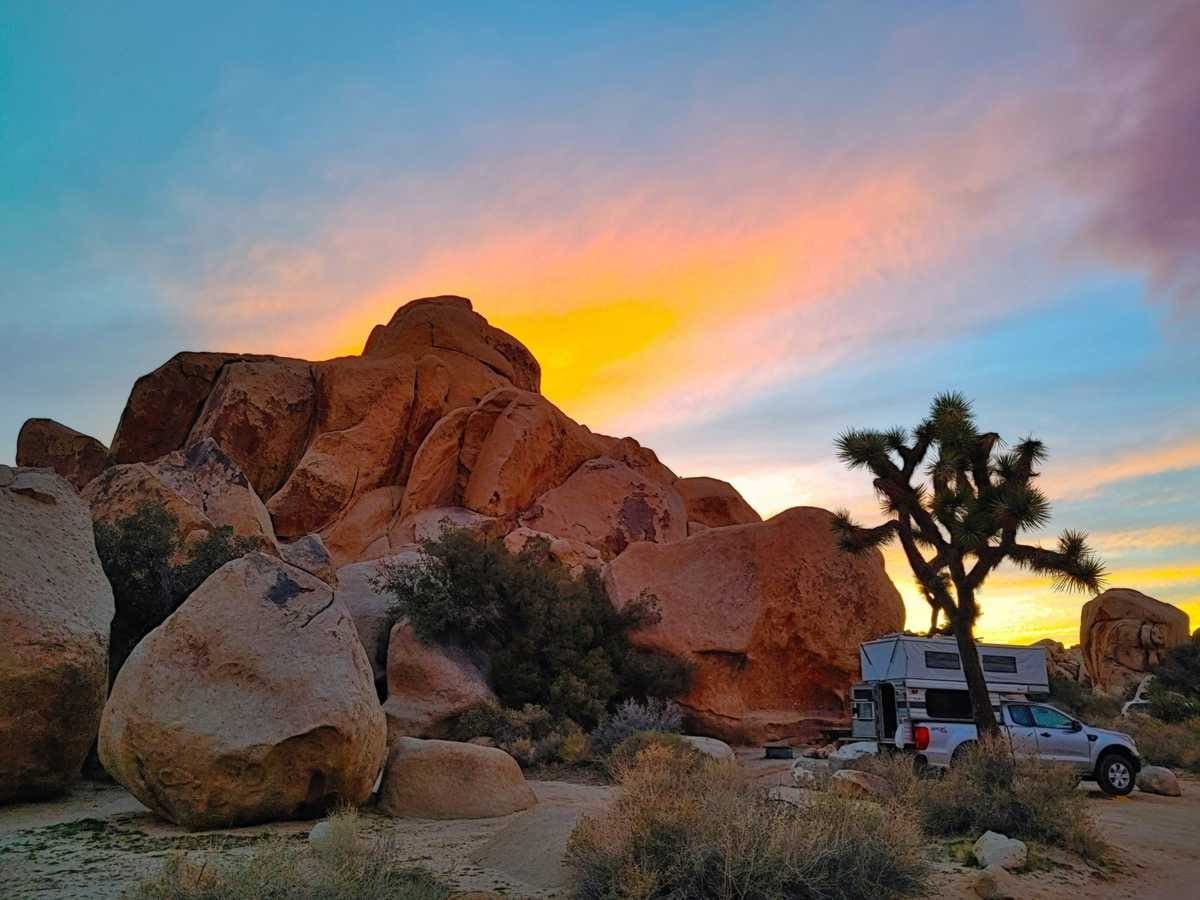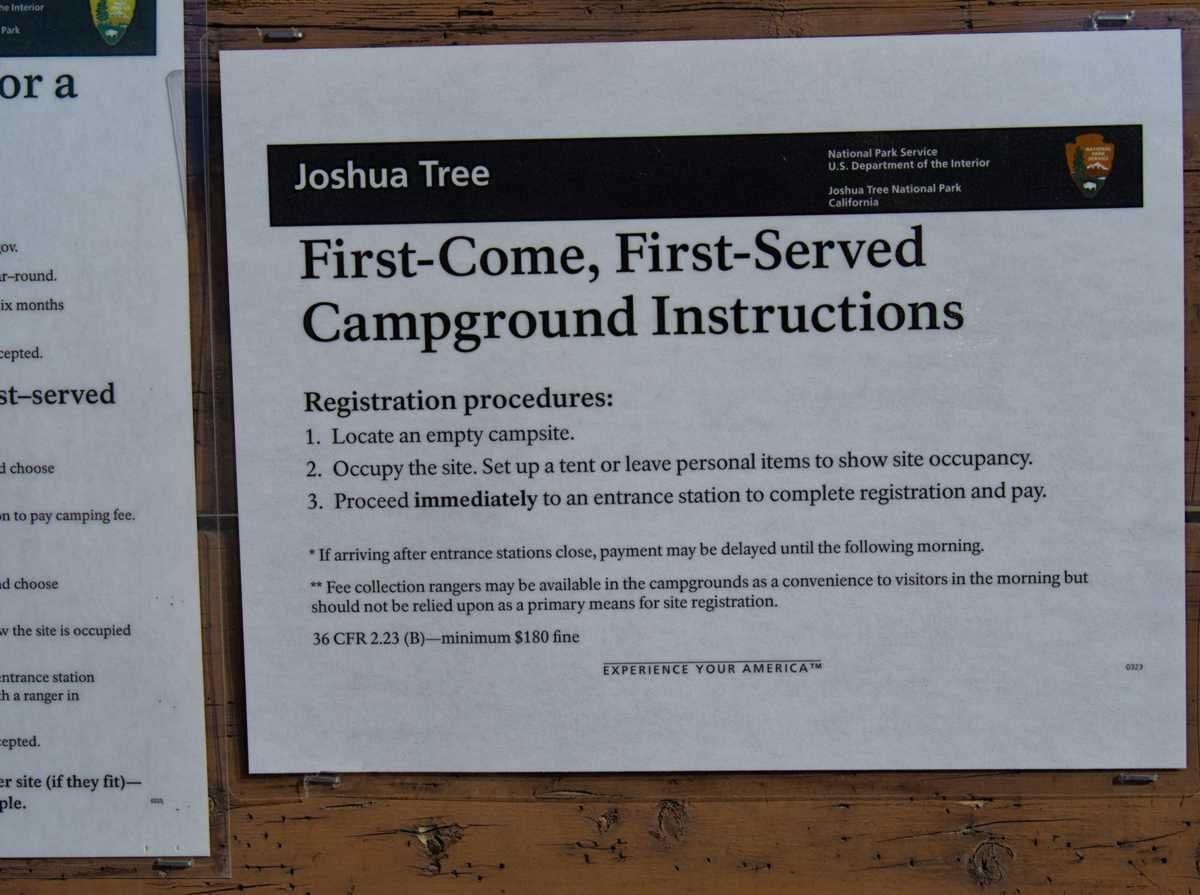I heard the strange sound as the white National Park Service Vehicle approached. It might have been a hovercraft mixed with a spaceship type of sound, but really it was just the extra noise electric vehicles make to let you know they are there and running. They stopped right in front of our campsite as the driver started poking the screen of his tablet and the passenger sat there and looked on. “I have to go and ask”, I said. I had to know why Joshua Tree National Park has the most onerous and wasteful system for purchasing a campsite of anywhere in the country. We’d been to 26 states in the past 12 months, and camped everywhere we went. I could think of a more idiotic system than the one they had devised here.

Note: This story is part of the series South to Spring. Click the link or head to our timeline for the other chapters of the trip.
We were camped at Hidden Valley Campground, in a fairly nice spot that actually had some space from the neighboring campsites, about as good as it gets for a National Park campsite in a campground. This conversation did actually take place, the rationale given by the ranger were all points he presented me with, except for my responses were kept to myself in my head, as I didn’t want to seem to confrontational to someone who likely is just a cog in the huge bureaucracy of the National Park Service.
We had first encountered the “system” that Joshua Tree National Park has for collecting payment for non-reservable sites back in 2018 on our first visit. The system consists of you entering the park, driving to the campgrounds that have non-reservable sites, and, if you are lucky finding an empty site. Once you occupy the site with some of your belongings to make it appear someone is staying there, you are expected to immediately return to the entrance to pay for the site, there is no option to pay at the campsite. For Hidden Valley that means an additional 20 mile round trip for each of the 44 campers (88 trips or 880 extra miles driven and fuel wasted) that pay for a night of camping! Unfortunately that system remains the same in 2024.

As I approached the vehicle the ranger said, “Hello, we are just collecting some statistics.”
I replied, “I just have to try to understand, why is it that you make people drive so many miles round trip just to pay for a campsite without giving an option to pay where you camp like almost every other campground in the country? Doesn’t the park service want to limit traffic and emissions? I would think they would have a more climate and visitor friendly system for collecting fees.”
“Oh yes, we get that question a lot, I guess we used to collect at the campgrounds but someone tried to break in once.”
“Really,” I said, “That’s too bad, and a little hard to believe with how many people are coming and going here that would be witnesses. It would be pretty hard to break out a cutting torch to cut the iron ranger open without dozens of witnesses. It seems to work in other campgrounds, even ones that are more remote with less people around, or larger ones that collect a lot more money than these campgrounds.”
“Well,” he said, “You don’t actually have to drive down to the entrance station to pay, someone usually comes around sometime in the morning that you can pay if you don’t drive to the entrance.” “Really,” I said, “The signs you have posted state pretty clearly in the instructions that you need to proceed immediately to pay upon arrival. The Code of Federal Regulations are cited and it says there is a $180 fine.”
“No you don’t have to go and pay, someone will come around at some point.”
“And it doesn’t say when someone will come by, I could already be out hiking for the day, if they come by at all. But that’s good, you don’t expect people to follow the posted rules then?”
“Yes,” he said, trying to move the conversation along, “And now that we have a system that doesn’t accept cash and requires people to drive to the entrance to pay, we collect over $1 million more on camping fees each year.”
“Wow, so the National Park Service, a division of the federal government, doesn’t accept the legal tender that is issued by the federal government? The bills that state on them that they are legal tender for all debts public and private? And you actually get more people to pay by limiting their payment options and requiring them to have a credit card, while driving 20 extra miles to hand over the fee? That’s pretty interesting.”
“Yes,” he went on, “and we just don’t have the resources to collect fees in every campground. We have the same funding from 40 years ago when barely anyone visited.”
“Oh really. Wait, didn’t you just say that you send someone around to collect the fees still? And didn’t you just say that camping fee revenue has increased by over a million dollars a year? I’d think that would pay for some sort of more efficient system.”
His stare off into the distance intensified a bit, so I looked over to his fellow employee in the passenger seat doing nothing except doubling the cost of whatever statistics he was collecting while he drove the campground. She returned the same practiced stare. “Well, I said, it must be tough not to have any funding, as I glanced at the brand new all electric vehicle. “You must really have to do without sometimes,” glancing at his ipad that has long replaced a clipboard.
“Yeah, we have talked about coming up with a payment kiosk so people didn’t have to drive, but without cell service out here we just haven’t been able to figure out a way for people to pay with a credit card.”

I looked in both directions at the next campsites, both equipped with solar powered Starlink internet antennas jutting up from the roofs of their vans. Those people were inside streaming Netflix movies instead of enjoying the sunny day. Sad, but that’s a different story. “Oh, so how does the person driving around collect payment out here, couldn’t you use a similar system to whatever that is to make a kiosk work?” I paused but there was just that stare again, so I continued on. “A payment kiosk would be nice. Say, I worked as a ranger in a state park back in the 1990’s and we collected credit card information at a payment kiosk way back then. We didn’t have any cell service and we made it work just fine, in a campground that was over five times the size of this one, so there must be a way to do it. If you needed internet service maybe you could use some of that $1 million extra dollars to buy a solar panel and a Starlink setup. You could get rid of the employee that drives around every day, sell that vehicle they drive and you’d be money ahead.”
“Yeah,” he replied, obviously tiring of the conversation, “it would be nice, but that’s just not how it works with the government.” On that point we agreed, nothing really works correctly with the government. He fired up the car, it started humming and buzzing, and I stepped back and wished him a good day. They passed through two more times through the course of the afternoon, apparently with plenty of time to collect voluminous statistics but not collect any fees. I wasn’t any closer to understanding the system they have devised, but now I understand it will still be the same if or when we return.


well the NPS has it’s issues, but for “Reservation.gov” all I can say is “Booz Allen Hamilton”. It they are not familiar to you, look it up or better yet, talk to your friendly neighborhood Congressman!
Yes, recreation.gov could be a whole post to itself for sure. What, you want me to pay an $8 fee to pay for a $6 site and you have no other options to pay but to login to a website when the nearest service is 10 miles away?!?
Your conversation with a ranger mirrors a conversation I had in Death Valley National Park in February. The Mesquite Springs pay kiosk was not working (credit card only). We were leaving for a hike from camp, would not consider driving to another pay station as the signage said to do, and I wanted to clip an envelope with $7 cash to the post at the campsite for payment if a ranger happened to come by in our absence. An NPS employee drove by before we left and I was told they cannot take cash. The reason: DVNP is so remote the bank is 104 miles away. My immediate response that, like you, I kindly kept to myself. “I bet the bank is right next to the grocery store you to drive to for supplies.”
Sooner or later they won’t even take a card, and you’ll have to buy a $1200 phone to pay your $7. Ugh.